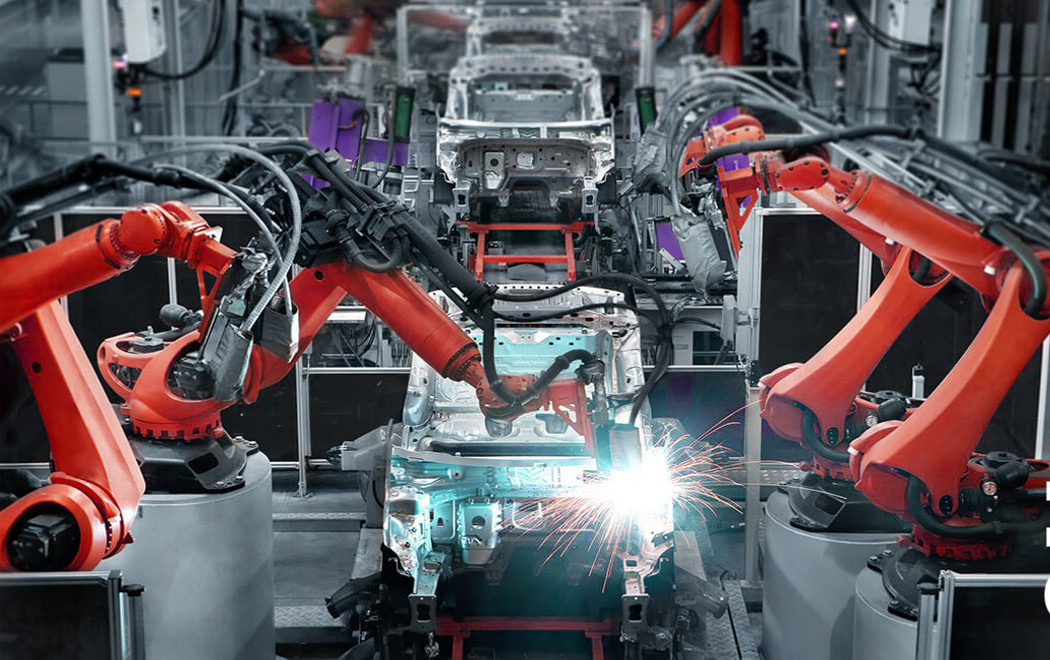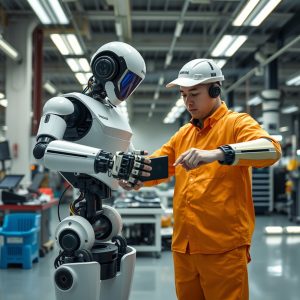
In today’s article, we will deal with the concept of progressive automation with business and the related concept of Industry 4.0. We will discuss the concept of an automated company to the maximum extent and several real-life scenarios.
What is automation in enterprises?
When we ask about automation in enterprises and industry – most often the first association with the use of machines in enterprises is for most of us positions filled with robots that perform work on the production line.
We often recall a car production line as an example. In this type of factory, there are many repetitive processes related to the processing of various materials.
Examples include the stamping of metal sheets, joining elements, cutting profiles and welding elements. The final element of such a line is the assembly of prefabricated elements and their final product assembly.
Of course, this is a very simplified process, but at this stage it is easy to indicate the situations in which automation works best.
Generally, the best place to use automation in production is when a given activity or sequence of activities is repeated many times, and at each stage the process can be divided into fairly simple and repeatable operations using various tools.
For such purposes, the so-called manipulators, i.e. robots equipped with various tools, such as welding ends, are best suited.
Without automation, each of these activities would be performed by a specialized employee, for example a welder, press operator or cutting machine operator.
Manipulators, also known as robotic arms, are devices for a fairly high versatility of applications. Thanks to the possibility of programming the sequence of movements.
Automated production lines are very spectacular and very widely used in car assembly lines.
However, this is not the only branch of industry in which we deal with automation and robots.
The second dynamically developing industry in which robots are used is all kinds of Logistics and warehouse services.
Large distribution centers complete parcels and ship them
Retail and wholesale giants like Amazon are a great example of this.
The company invests and develops fully automated warehouse halls where robots are able to segregate packages and complete orders virtually without human intervention.
However, if you delve into the subject, this is just the tip of the iceberg. In fact, it is just one of the few processes that can be automated.
The scope of automation application.
Manufacturing and trading companies perform many other activities that could be successfully performed by specialized machines or software.
Essentially, every company that carries out commercial activities must receive orders from end customers or business intermediaries and prepare them according to the provided assumptions.
Therefore, at the very beginning of the process of offering and placing an order, we can apply mechanisms that allow us to eliminate the need to hire employees.
In the remainder of the article, we would like to consider a hypothetical enterprise in which all processes from the beginning to the end of the business process.
So we will start with offering, placing an order and ending with selling, making payments and delivering the product. We will also not forget about the order evaluation, after-sales care and possible warranty service.
All of the above-mentioned steps will be implemented in a fully automated ecosystem
We consider the existence of a fully automated enterprise in which all processes are performed without human.
What is Industry 4.0?
Industry 4.0 refers to a new phase in the Industrial Revolution that focuses heavily on automation, machine learning, and real-time data.
Industry 4.0, which encompasses IIoT and smart manufacturing, marries physical production and operations with smart digital technology, machine learning, and big data to create a more holistic and better connected ecosystem for companies that focus on manufacturing and supply chain management.
While every company and organization operating today is different, they all face a common challenge—the need for continuous integration and access to real-time insights across processes, partners, products, and people.
The role of Machine Learning in Industry 4.0 automation
More and more perfect algorithms based on machine learning allow to optimize the process on an unprecedented scale.
Classic human-made algorithms are being replaced by machine learning-based algorithms – where the human – programmer becomes less and less of a role.
In algorithms based on machine learning – the role of a human being is reduced to presenting the problem (output parameters) and the method of its evaluation.
It is the machine that carries out the process of self-improvement until it reaches a satisfactory level of performance of the creator.
The problem itself is solved based on the “black box” approach.
These new techniques enable us to create efficient methods without any of the human intervention, but with less than 1% difference in performance between two algorithms with identical input and with different values of input parameters.
The performance of each algorithm is then calculated by a combination of factors, and this performance data is fed into an evaluation algorithm which generates predictions for new algorithms based on the previous analysis algorithm. As soon as these estimates are known, they are updated with the new results from the evaluation algorithm.
A final decision is made on all available predictions by picking the best know so far.
So if you look at the top 3 best performing algorithms (i.e. the algorithm whose predictions are actually delivered, without human intervention) you’ll see a pretty striking pattern, and it’s quite interesting: we only need to apply one of these recommendations when building algorithms.
We do not need to rely on any other recommendation when constructing a new algorithm, for example, a method based on some existing algorithm is more than sufficient to build new algorithms.
A very similar approach can be applied to building a new machine learning algorithm.
We can look at existing algorithms and find a few which are very good. We can also look at algorithms which have been built on top of existing libraries and make some very simple modifications to them.
The resulting algorithm will be much faster than the algorithm it replaces. This can also be applied to new libraries, which can all have their own features which improve their performance.
The benefits of automation in business.
There is no need to convince anyone about the benefits of automation, this topic is quite heavily commented on and there are a number of publications on this topic.
We will highlight here only the most important benefits, without going into details that go beyond the scope of this publication.
Automation of processes in the company is necessary from an economic point of view.
The gradual replacement of employees with robots and software allows to reduce production and logistics costs along with the increase in the scale of the project.
In the case of manufacturing, automation would allow for the rapid removal of humans from production line to make way for more powerful machines (as well as a large cut in the total cost of production).
In the US in the last half of the 19th century, this technology was a key component of the Ford Model T, which used a Ford assembly line to make the engine, transmission, gearbox and the rest.
The automation of the entire process and the removal of humans from the process would not only reduce the amount of time it is necessary to perform the same job, but would also help to save money.
The goals of automation are not only to increase productivity but also improve safety. Of course it takes money to automated a process for the first time. And yes, this cost could be really high compared to workers salary. But if you look for this as an investment and consider bigger perspective – you may find out that this is worth the money.
You need always to calculate the overall cost of the venture and it should be calculated over some longer period.
Thanks to that the investment outlays have the chance to pay for themselves and then earn for themselves.
In the next part we will conduct a thought experiment and a project of a fully automated enterprise in several industry variants.






